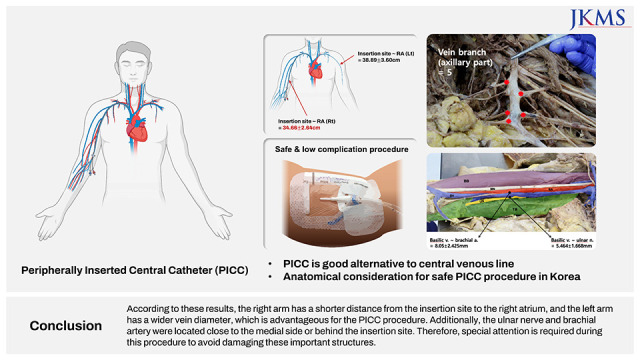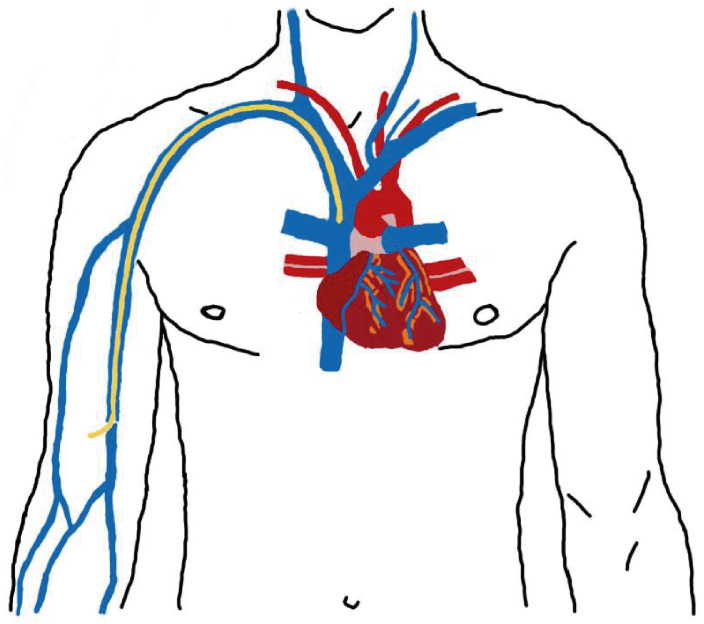1. Gabriel J. An intravenous alternative. Nurs Times. 1994; 90(31):39–41.
2. Walshe LJ, Malak SF, Eagan J, Sepkowitz KA. Complication rates among cancer patients with peripherally inserted central catheters. J Clin Oncol. 2002; 20(15):3276–3281. PMID:
12149302.
3. Ruesch S, Walder B, Tramèr MR. Complications of central venous catheters: internal jugular versus subclavian access--a systematic review. Crit Care Med. 2002; 30(2):454–460. PMID:
11889329.
4. Tan PL, Gibson M. Central venous catheters: the role of radiology. Clin Radiol. 2006; 61(1):13–22. PMID:
16356812.
5. Griffiths VR, Philpot P. Peripherally inserted central catheters (PICCs): do they have a role in the care of the critically ill patient? Intensive Crit Care Nurs. 2002; 18(1):37–47. PMID:
12008876.
6. O’Grady NP, Alexander M, Burns LA, Dellinger EP, Garland J, Heard SO, et al. Guidelines for the prevention of intravascular catheter-related infections. Am J Infect Control. 2011; 39(4):Suppl 1. S1–34. PMID:
21511081.
7. Bourgeois FC, Lamagna P, Chiang VW. Peripherally inserted central catheters. Pediatr Emerg Care. 2011; 27(6):556–561. PMID:
21642797.
8. Hoshal VL Jr. Total intravenous nutrition with peripherally inserted silicone elastomer central venous catheters. Arch Surg. 1975; 110(5):644–646. PMID:
805577.
9. Al Raiy B, Fakih MG, Bryan-Nomides N, Hopfner D, Riegel E, Nenninger T, et al. Peripherally inserted central venous catheters in the acute care setting: a safe alternative to high-risk short-term central venous catheters. Am J Infect Control. 2010; 38(2):149–153. PMID:
19836854.
10. Fearonce G, Faraklas I, Saffle JR, Cochran A. Peripherally inserted central venous catheters and central venous catheters in burn patients: a comparative review. J Burn Care Res. 2010; 31(1):31–35. PMID:
20061834.
11. Evans RS, Sharp JH, Linford LH, Lloyd JF, Woller SC, Stevens SM, et al. Reduction of peripherally inserted central catheter-associated DVT. Chest. 2013; 143(3):627–633. PMID:
22878346.
12. Chopra V, Ratz D, Kuhn L, Lopus T, Lee A, Krein S. Peripherally inserted central catheter-related deep vein thrombosis: contemporary patterns and predictors. J Thromb Haemost. 2014; 12(6):847–854. PMID:
24612469.
13. Parienti JJ, Mongardon N, Mégarbane B, Mira JP, Kalfon P, Gros A, et al. Intravascular complications of central venous catheterization by insertion site. N Engl J Med. 2015; 373(13):1220–1229. PMID:
26398070.
14. Puri A, Dai H, Giri M, Wu C, Huang H, Zhao Q. The incidence and risk of venous thromboembolism associated with peripherally inserted central venous catheters in hospitalized patients: a systematic review and meta-analysis. Front Cardiovasc Med. 2022; 9:917572. PMID:
35958406.
15. Patel GS, Jain K, Kumar R, Strickland AH, Pellegrini L, Slavotinek J, et al. Comparison of peripherally inserted central venous catheters (PICC) versus subcutaneously implanted port-chamber catheters by complication and cost for patients receiving chemotherapy for non-haematological malignancies. Support Care Cancer. 2014; 22(1):121–128. PMID:
24005884.
16. Sofocleous CT, Schur I, Cooper SG, Quintas JC, Brody L, Shelin R. Sonographically guided placement of peripherally inserted central venous catheters: review of 355 procedures. AJR Am J Roentgenol. 1998; 170(6):1613–1616. PMID:
9609183.
17. Fong NI, Holtzman SR, Bettmann MA, Bettis SJ. Peripherally inserted central catheters: outcome as a function of the operator. J Vasc Interv Radiol. 2001; 12(6):723–729. PMID:
11389224.
18. Barber JM, Booth DM, King JA, Chakraverty S. A nurse led peripherally inserted central catheter line insertion service is effective with radiological support. Clin Radiol. 2002; 57(5):352–354. PMID:
12014930.
19. Froehlich CD, Rigby MR, Rosenberg ES, Li R, Roerig PL, Easley KA, et al. Ultrasound-guided central venous catheter placement decreases complications and decreases placement attempts compared with the landmark technique in patients in a pediatric intensive care unit. Crit Care Med. 2009; 37(3):1090–1096. PMID:
19237922.
20. Bowdle A. Vascular complications of central venous catheter placement: evidence-based methods for prevention and treatment. J Cardiothorac Vasc Anesth. 2014; 28(2):358–368. PMID:
24008166.
21. Gullo G, Qanadli SD. ECG-based techniques to optimize peripherally inserted central catheters: rationale for tip positioning and practical use. Front Cardiovasc Med. 2022; 9:765935. PMID:
35600463.
22. Thiagarajan RR, Ramamoorthy C, Gettmann T, Bratton SL. Survey of the use of peripherally inserted central venous catheters in children. Pediatrics. 1997; 99(2):E4.
23. Jain A, Deshpande P, Shah P. Peripherally inserted central catheter tip position and risk of associated complications in neonates. J Perinatol. 2013; 33(4):307–312. PMID:
22955288.
24. Kleidon TM, Schults J, Rickard CM, Ullman AJ. Techniques and technologies to improve peripheral intravenous catheter outcomes in pediatric patients: systematic review and meta-analysis. J Hosp Med. 2021; 16(12):742–750. PMID:
34797998.
25. Zhu LB, Liu L, Zhang TS, Zheng YT, Lu CY, Lu K, et al. A clinical study on the tip localization of peripherally inserted central catheter (PICC) guided by intracavitary electrocardiography in newborns: a randomised trial. Transl Pediatr. 2021; 10(10):2409–2417. PMID:
34765464.
26. Yap YS, Karapetis C, Lerose S, Iyer S, Koczwara B. Reducing the risk of peripherally inserted central catheter line complications in the oncology setting. Eur J Cancer Care (Engl). 2006; 15(4):342–347. PMID:
16968315.
27. Kyle KS, Myers JS. Peripherally inserted central catheters. Development of a hospital-based program. J Intraven Nurs. 1990; 13(5):287–290. PMID:
2401933.
28. Cardella JF, Fox PS, Lawler JB. Interventional radiologic placement of peripherally inserted central catheters. J Vasc Interv Radiol. 1993; 4(5):653–660. PMID:
8219560.
29. Parkinson R, Gandhi M, Harper J, Archibald C. Establishing an ultrasound guided peripherally inserted central catheter (PICC) insertion service. Clin Radiol. 1998; 53(1):33–36. PMID:
9464433.
30. Duerksen DR, Papineau N, Siemens J, Yaffe C. Peripherally inserted central catheters for parenteral nutrition: a comparison with centrally inserted catheters. JPEN J Parenter Enteral Nutr. 1999; 23(2):85–89. PMID:
10081998.
31. Johansson E, Hammarskjöld F, Lundberg D, Arnlind MH. Advantages and disadvantages of peripherally inserted central venous catheters (PICC) compared to other central venous lines: a systematic review of the literature. Acta Oncol. 2013; 52(5):886–892. PMID:
23472835.
32. Pitiriga V, Bakalis J, Theodoridou K, Kanellopoulos P, Saroglou G, Tsakris A. Lower risk of bloodstream infections for peripherally inserted central catheters compared to central venous catheters in critically ill patients. Antimicrob Resist Infect Control. 2022; 11(1):137. PMID:
36352414.
33. Levy I, Bendet M, Samra Z, Shalit I, Katz J. Infectious complications of peripherally inserted central venous catheters in children. Pediatr Infect Dis J. 2010; 29(5):426–429. PMID:
20016395.
34. Chopra V, Flanders SA, Saint S. The problem with peripherally inserted central catheters. JAMA. 2012; 308(15):1527–1528. PMID:
23073947.
35. Uchida S, Takekawa D, Hori M, Hashiba E, Hirota K. Bedside insertion of a peripherally inserted central catheter into a patient with BMI of 84.8 kg/m
2 using a magnetic tracking and electrocardiogram-based tip confirmation system: a case report. JA Clin Rep. 2022; 8(1):69. PMID:
36029359.
36. Delgado Márquez JC. Use of peripheral insertion central venous catheter in kidney transplant patients: an alternative. Exp Clin Transplant. 2022; 20:153–155. PMID:
35384828.
37. Narita A, Takehara Y, Maruchi Y, Matsunaga N, Ikeda S, Izumi Y, et al. Usefulness of peripherally inserted central catheter port system (PICC-PORT) implantation in the sitting position: a new technique for cases unsuitable for conventional implantation. Jpn J Radiol. 2023; 41(1):108–113. PMID:
35943686.
38. Moureau N. Vascular safety: it’s all about PICCs. Nurs Manage. 2006; 37(5):22–27.
39. Kim DH. Bedside peripherally inserted central catheter placement: focus on the procedure. Trauma Image Proced. 2022; 7(1):21–26.
40. Seo HK, Hwang JH, Shin MJ, Kim SY, Song KH, Kim ES, et al. Two-year hospital-wide surveillance of central line-associated bloodstream infections in a Korean hospital. J Korean Med Sci. 2018; 33(45):e280. PMID:
30402047.
41. Park JY, Kim HL. A comprehensive review of clinical nurse specialist-led peripherally inserted central catheter placement in Korea: 4101 cases in a tertiary hospital. J Infus Nurs. 2015; 38(2):122–128. PMID:
25723834.
42. Park S, Moon S, Pai H, Kim B. Appropriate duration of peripherally inserted central catheter maintenance to prevent central line-associated bloodstream infection. PLoS One. 2020; 15(6):e0234966. PMID:
32569313.
43. Park JY, Park KO, Baek MK, Kim SR, Kwon HL, Yang SJ. Analysis of PICC inserted patient data in a hospital by IV CNS-driven intervention. J Korean Biol Nurs Sci. 2004; 6(1):33–42.
44. Song C, Oh H. Burn patients’ experience of peripherally inserted central catheter insertion: analysis of focus group interviews from a South Korean burn center. Burns. 2016; 42(7):1439–1444. PMID:
27156805.
45. Kim HJ, Yun J, Kim HJ, Kim KH, Kim SH, Lee SC, et al. Safety and effectiveness of central venous catheterization in patients with cancer: prospective observational study. J Korean Med Sci. 2010; 25(12):1748–1753. PMID:
21165289.
46. Yun WS, Yang SS. Comparison of peripherally inserted central catheters and totally implanted venous access devices as chemotherapy delivery routes in oncology patients: a retrospective cohort study. Sci Prog. 2021; 104(2):368504211011871. PMID:
33950754.
47. Ryu DY, Lee SB, Kim GW, Kim JH. A peripherally inserted central catheter is a safe and reliable alternative to short-term central venous catheter for the treatment of trauma patients. J Trauma Inj. 2019; 32(3):150–156.
48. Lee Y, Ryu JA, Kim YO, Gil E, Song YM. Safety and feasibility of ultrasound-guided insertion of peripherally inserted central catheter performed by an intensive care trainee. J Neurocrit Care. 2020; 13(1):41–48.
49. Kim HJ, Jung CY, Min BJ. Clinical characteristics of peripherally inserted central catheter in critically ill patients. J Acute Care Surg. 2019; 9(1):18–24.
50. Yu B, Hong J. Safety and efficacy of peripherally inserted central catheter placement by surgical intensivist-led vascular access team. Vasc Spec Int. 2022; 38:41.
51. Cho HH, Jeon EY, Lee HJ, Lee H, Koh SH, Choi SY, et al. A new formula to estimate the length of right upper extremity vein from elbow crease to carina calculated by peripherally inserted central catheter insertion through right basilic vein puncture. J Korean Soc Radiol. 2012; 66(3):229–233.
52. Kang SS, Shin YS, Lee SY, Kim H. Simplified equation for determining proper depth of peripherally inserted central catheter in relation to anatomical landmarks. Korean J Anesthesiol. 2018; 71(4):300–304. PMID:
29684986.
53. Paterson RS, Schults JA, Slaughter E, Cooke M, Ullman A, Kleidon TM, et al. Review article: peripheral intravenous catheter insertion in adult patients with difficult intravenous access: a systematic review of assessment instruments, clinical practice guidelines and escalation pathways. Emerg Med Australas. 2022; 34(6):862–870. PMID:
36038953.
54. Forauer AR, Alonzo M. Change in peripherally inserted central catheter tip position with abduction and adduction of the upper extremity. J Vasc Interv Radiol. 2000; 11(10):1315–1318. PMID:
11099242.
55. Sperry BW, Roskos M, Oskoui R. The effect of laterality on venous thromboembolism formation after peripherally inserted central catheter placement. J Vasc Access. 2012; 13(1):91–95. PMID:
21948128.
56. Allen AW, Megargell JL, Brown DB, Lynch FC, Singh H, Singh Y, et al. Venous thrombosis associated with the placement of peripherally inserted central catheters. J Vasc Interv Radiol. 2000; 11(10):1309–1314. PMID:
11099241.
57. Lopez ON, Lorenc JM, Reading BD, Juang D, Aguayo P. Peripherally inserted central venous access. Semin Pediatr Surg. 2021; 30(6):151119. PMID:
34930595.
58. Puhaindran ME, Wong HP. A case of anterior interosseous nerve syndrome after peripherally inserted central catheter (PICC) line insertion. Singapore Med J. 2003; 44(12):653–655. PMID:
14770261.
59. Alomari A, Falk A. Median nerve bisection: a morbid complication of a peripherally inserted central catheter. J Vasc Access. 2006; 7(3):129–131. PMID:
17019665.
60. Kikuchi M, Sawada M, Nomura T, Mizuno Y, Goto T. Asymptomatic penetration of the median nerve by a peripherally inserted central catheter: a case report. A A Pract. 2022; 16(3):e01577. PMID:
35324514.








 PDF
PDF Citation
Citation Print
Print






 XML Download
XML Download